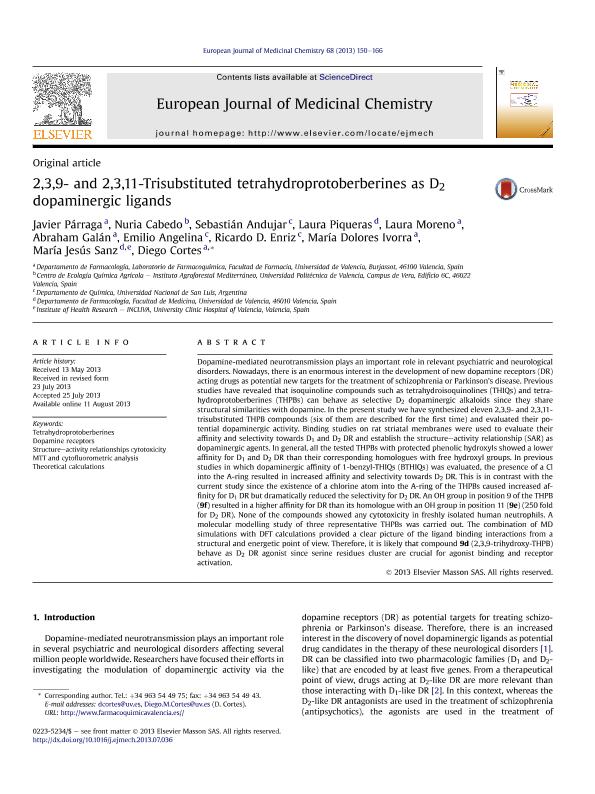Mostrar el registro sencillo del ítem
dc.contributor.author
Párraga, Javier
dc.contributor.author
Cabedo, Nuria
dc.contributor.author
Andújar, Sebastián Antonio

dc.contributor.author
Piqueras, Laura
dc.contributor.author
Moreno, Laura
dc.contributor.author
Galán, Abraham
dc.contributor.author
Angelina, Emilio Luis

dc.contributor.author
Enriz, Ricardo Daniel

dc.contributor.author
Ivorra, María Dolores
dc.contributor.author
Sanz, María Jesús
dc.contributor.author
Cortes, Diego
dc.date.available
2016-02-22T19:42:56Z
dc.date.issued
2013-08-11
dc.identifier.citation
Párraga, Javier; Cabedo, Nuria; Andújar, Sebastián Antonio; Piqueras, Laura; Moreno, Laura; et al.; 2,3,9- and 2,3,11-Trisubstituted tetrahydroprotoberberines as D2 dopaminergic ligands; Elsevier; European Journal of Medical Chemistry; 68; 11-8-2013; 150-166
dc.identifier.issn
0223-5234
dc.identifier.uri
http://hdl.handle.net/11336/4361
dc.description.abstract
Dopamine-mediated neurotransmission plays an important role in relevant psychiatric and neurological disorders. Nowadays, there is an enormous interest in the development of new dopamine receptors (DR) acting drugs as potential new targets for the treatment of schizophrenia or Parkinson's disease. Previous studies have revealed that isoquinoline compounds such as tetrahydroisoquinolines (THIQs) and tetrahydroprotoberberines (THPBs) can behave as selective D2 dopaminergic alkaloids since they share structural similarities with dopamine. In the present study we have synthesized eleven 2,3,9- and 2,3,11-trisubstituted THPB compounds (six of them are described for the first time) and evaluated their potential dopaminergic activity. Binding studies on rat striatal membranes were used to evaluate their affinity and selectivity towards D1 and D2 DR and establish the structure–activity relationship (SAR) as dopaminergic agents. In general, all the tested THPBs with protected phenolic hydroxyls showed a lower affinity for D1 and D2 DR than their corresponding homologues with free hydroxyl groups. In previous studies in which dopaminergic affinity of 1-benzyl-THIQs (BTHIQs) was evaluated, the presence of a Cl into the A-ring resulted in increased affinity and selectivity towards D2 DR. This is in contrast with the current study since the existence of a chlorine atom into the A-ring of the THPBs caused increased affinity for D1 DR but dramatically reduced the selectivity for D2 DR. An OH group in position 9 of the THPB (9f) resulted in a higher affinity for DR than its homologue with an OH group in position 11 (9e) (250 fold for D2 DR). None of the compounds showed any cytotoxicity in freshly isolated human neutrophils. A molecular modelling study of three representative THPBs was carried out. The combination of MD simulations with DFT calculations provided a clear picture of the ligand binding interactions from a structural and energetic point of view. Therefore, it is likely that compound 9d (2,3,9-trihydroxy-THPB) behave as D2 DR agonist since serine residues cluster are crucial for agonist binding and receptor activation.
dc.format
application/pdf
dc.language.iso
eng
dc.publisher
Elsevier

dc.rights
info:eu-repo/semantics/openAccess
dc.rights.uri
https://creativecommons.org/licenses/by-nc-nd/2.5/ar/
dc.subject
Tetrahydroprotoberberines
dc.subject
Dopamine Receptors
dc.subject
Structureeactivity Relationships Cytotoxicity
dc.subject
Theoretical Calculations
dc.subject.classification
Bioquímica y Biología Molecular

dc.subject.classification
Ciencias Biológicas

dc.subject.classification
CIENCIAS NATURALES Y EXACTAS

dc.title
2,3,9- and 2,3,11-Trisubstituted tetrahydroprotoberberines as D2 dopaminergic ligands
dc.type
info:eu-repo/semantics/article
dc.type
info:ar-repo/semantics/artículo
dc.type
info:eu-repo/semantics/publishedVersion
dc.date.updated
2016-03-30 10:35:44.97925-03
dc.journal.volume
68
dc.journal.pagination
150-166
dc.journal.pais
Francia

dc.journal.ciudad
Paris
dc.description.fil
Fil: Párraga, Javier. Universidad de Valencia. Facultad de Farmacia. Departamento de Farmacología, Laboratorio de Farmacoquímica; España
dc.description.fil
Fil: Cabedo, Nuria. Universidad Politécnica de Valencia. Centro de Ecología Química Agrícola e Instituto Agroforestal Mediterráneo; España
dc.description.fil
Fil: Andújar, Sebastián Antonio. Universidad Nacional de San Luis; Argentina. Consejo Nacional de Investigaciones Científicas y Técnicas. Centro Científico Tecnológico San Luis. Instituto Multidisciplinario de Investigaciones Biológicas de San Luis; Argentina
dc.description.fil
Fil: Piqueras, Laura. Universidad de Valencia. Facultad de Medicina. Departamento de Farmacología; España
dc.description.fil
Fil: Moreno, Laura. Universidad de Valencia. Facultad de Farmacia. Departamento de Farmacología, Laboratorio de Farmacoquímica; España
dc.description.fil
Fil: Galán, Abraham. Universidad de Valencia. Facultad de Farmacia. Departamento de Farmacología, Laboratorio de Farmacoquímica; España
dc.description.fil
Fil: Angelina, Emilio Luis. Universidad Nacional de San Luis; Argentina
dc.description.fil
Fil: Enriz, Ricardo Daniel. Universidad Nacional de San Luis; Argentina. Consejo Nacional de Investigaciones Científicas y Técnicas. Centro Científico Tecnológico San Luis. Instituto Multidisciplinario de Investigaciones Biológicas de San Luis; Argentina
dc.description.fil
Fil: Ivorra, María Dolores. Universidad de Valencia. Facultad de Farmacia. Departamento de Farmacología, Laboratorio de Farmacoquímica; España
dc.description.fil
Fil: Sanz, María Jesús. Universidad de Valencia. Facultad de Medicina. Departamento de Farmacología; España. Instituto de Investigación Sanitaria; España
dc.description.fil
Fil: Cortes, Diego. Universidad de Valencia. Facultad de Farmacia. Departamento de Farmacología, Laboratorio de Farmacoquímica; España
dc.journal.title
European Journal of Medical Chemistry

dc.relation.alternativeid
info:eu-repo/semantics/altIdentifier/url/http://www.sciencedirect.com/science/article/pii/S0223523413004844
dc.relation.alternativeid
info:eu-repo/semantics/altIdentifier/doi/http://dx.doi.org/10.1016/j.ejmech.2013.07.036
dc.relation.alternativeid
info:eu-repo/semantics/altIdentifier/issn/0223-5234
Archivos asociados
